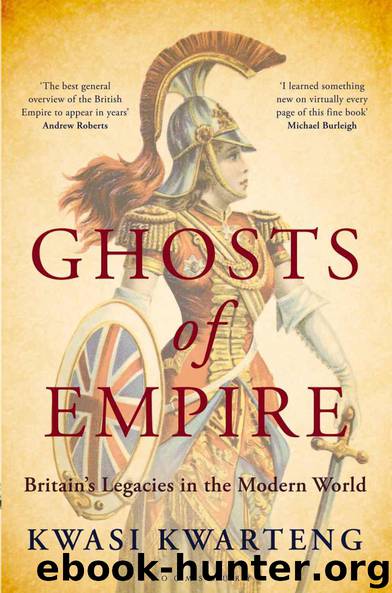Ghosts of Empire by Kwarteng Kwasi

Author:Kwarteng, Kwasi [Kwarteng, Kwasi]
Language: eng
Format: epub
Publisher: Bloomsbury UK
Published: 2011-08-15T07:00:00+00:00
Yet more wonderful were the women . . . There were at least three of them to every man. Black women from Equatoria [the southern province of Sudan] and almost white women from Egypt, plum-skinned Arabs and a strange yellow type with square, bony faces and tightly-ringleted black hair . . . the whole city was a huge harem, a museum of African races, a monstrosity of African lust.51
Steevens, the sophisticated Classical scholar, would have appreciated the irony of his describing ‘African lust’ in such vivid colours to bored commuters from Bromley and other London suburbs, the ‘office boys’, in Lord Salisbury’s sneering phrase, who read the Daily Mail. This type of mock indignation, combined with a secret titillation, has informed mass-market newspapers ever since. Kitchener, of course, would have regarded himself as being above such basic impulses. As the victor of the Sudan, he reached his apogee as a national hero. At the end of 1898, following the Battle of Omdurman, he was raised to the peerage as Baron Kitchener of Khartoum, and was known as K of K ever after. He was given £30,000 to support the dignity of his new status, and, because of his frugal bachelor lifestyle, he hoarded considerable wealth. There was the slight scandal of the destruction of the Mahdi’s tomb, when it was reported that Kitchener had taken the dead man’s skull as a trophy of war, while throwing the rest of his remains into the Nile. Even Queen Victoria expressed concern about these reports, writing to Kitchener to say that the ‘destruction of the body of the Mahdi who – whether he was very bad and cruel – was a man of a certain importance . . . savours . . . too much of the Middle Ages’.52 Kitchener justified his action in destroying the body and tomb on political grounds, and denied ever taking possession of the Mahdi’s skull.
The cult of Kitchener now reached its most vivid expression. The New Penny Magazine, a publication which catered for the burgeoning lower-middle-class public, for whom the Daily Mail had been launched, included a lengthy profile of the newly ennobled Kitchener of Khartoum in its edition at the end of November 1898, less than three months after the Battle of Omdurman. Kitchener’s looks were dilated on at some length; he is ‘as dark as an Arab, with a fine figure and commanding presence’. This description was a good excuse to recount tales of his adopting disguises while wandering the Sudan as an intelligence officer. Although Kitchener led a dull private life, the New Penny Magazine tried to present a more human side to the great warlord: he collected porcelain and was a devoted numismatist, possessing an ‘unrivalled collection’ of Eastern coins; ‘though a bachelor, he is noted in Cairo as a host’, while in London the ‘Sirdar spends most of his time at one of the well-known service clubs’; ‘his knowledge of foreign languages is exceptional’.53
In addition to his status as a cult figure, Kitchener enjoyed warm relations with Queen Victoria.
Download
This site does not store any files on its server. We only index and link to content provided by other sites. Please contact the content providers to delete copyright contents if any and email us, we'll remove relevant links or contents immediately.
| Arms Control | Diplomacy |
| Security | Trades & Tariffs |
| Treaties | African |
| Asian | Australian & Oceanian |
| Canadian | Caribbean & Latin American |
| European | Middle Eastern |
| Russian & Former Soviet Union |
The Secret History by Donna Tartt(18851)
The Social Justice Warrior Handbook by Lisa De Pasquale(12143)
Thirteen Reasons Why by Jay Asher(8799)
This Is How You Lose Her by Junot Diaz(6796)
Weapons of Math Destruction by Cathy O'Neil(6148)
Zero to One by Peter Thiel(5689)
Beartown by Fredrik Backman(5600)
The Myth of the Strong Leader by Archie Brown(5427)
The Fire Next Time by James Baldwin(5250)
How Democracies Die by Steven Levitsky & Daniel Ziblatt(5129)
Promise Me, Dad by Joe Biden(5088)
Stone's Rules by Roger Stone(5027)
A Higher Loyalty: Truth, Lies, and Leadership by James Comey(4846)
100 Deadly Skills by Clint Emerson(4840)
Rise and Kill First by Ronen Bergman(4705)
Secrecy World by Jake Bernstein(4648)
The David Icke Guide to the Global Conspiracy (and how to end it) by David Icke(4628)
The Farm by Tom Rob Smith(4439)
The Doomsday Machine by Daniel Ellsberg(4417)
